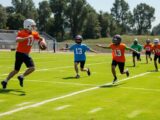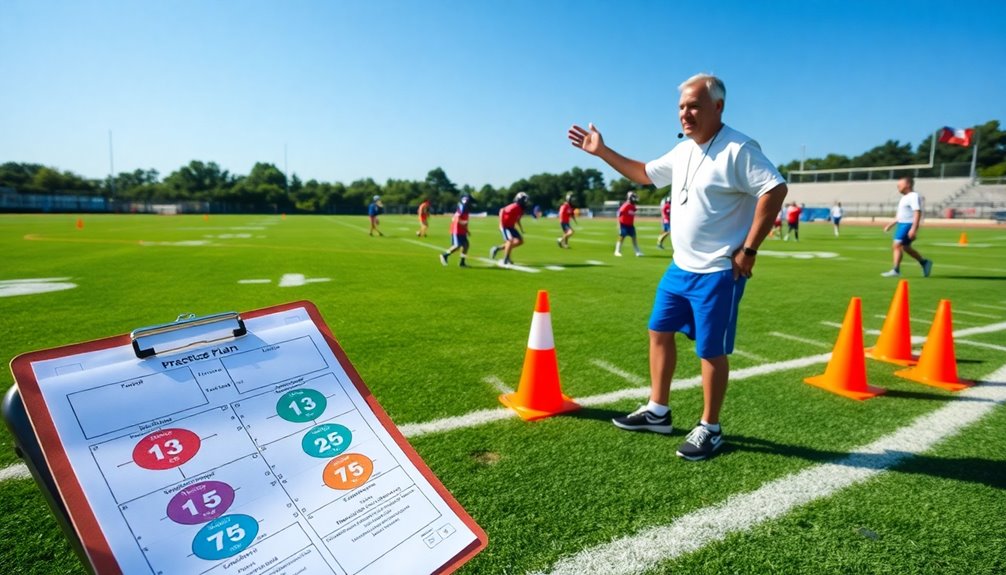
How to Create an Effective Flag Football Practice Plan
January 19, 2025To create an effective flag football practice plan, start with a structured warm-up that includes dynamic stretches and agility drills to prevent injuries. Incorporate essential drills for passing, catching, and defensive flag-pulling to build skills. Schedule scrimmages early to maximize focus and engagement, using small-sided games for teamwork. Remember hydration; provide water breaks every 15-20 minutes to keep players energized. Make practice enjoyable with fun drills and team-building activities that enhance relationships. Finally, set clear objectives for each session and adjust them as the season progresses. There's much more to enhance your practice plan further.
Importance of Warm-Up
By keeping your warm-ups varied and structured, you'll enhance not just player focus but also overall readiness for practice or competition. Prioritizing this aspect of training sets the stage for a successful and injury-free experience on the field. Incorporating dynamic stretches in your warm-up routine can significantly improve flexibility and help prevent injuries. Additionally, incorporating agility drills during warm-ups can further enhance players' readiness for the quick movements required in flag football. Furthermore, integrating core strength exercises into the warm-up can improve overall stability and power generation during gameplay.
Essential Flag Football Drills
To build a successful flag football team, incorporating essential drills that focus on fundamental skills is critical. Start with targeted passing and catching drills to enhance player proficiency. Use throwing, catching, and snapping exercises to develop these core abilities, ensuring your players are comfortable with the basics. Additionally, understanding the basic rules of the game can help players make better decisions during drills.
Next, implement offensive strategy drills that include specific routes and plays tailored for different positions. This approach will boost team coordination and execution during games. Make sure your practice plan allocates time based on your team's strengths and weaknesses, focusing on areas that need improvement.
Don't forget about defensive drills! Emphasizing flag-pulling techniques is important for improving your players' ability to stop opposing players effectively. Practicing these skills regularly will lead to better defensive performance in games.
Additionally, incorporate small-sided games like 2-on-2 or 3-on-3 to give players more touches and realistic gameplay scenarios. These setups allow your athletes to apply their skills in a fun, competitive environment, making your practice more engaging. Moreover, consistent effort in technical skills is crucial for refining abilities and enhancing overall team performance.
Structuring Scrimmages Effectively
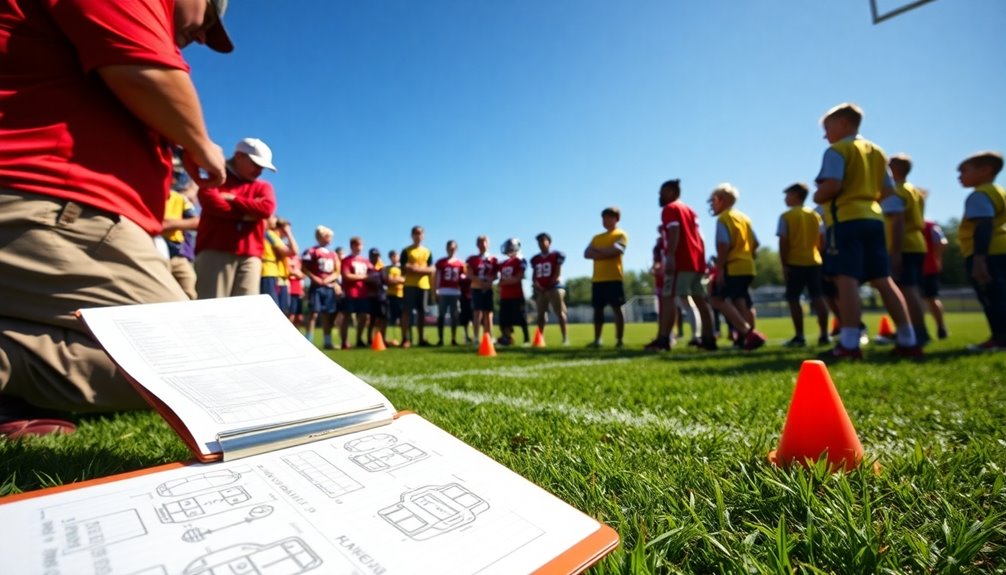
Effective scrimmages are essential for enhancing your team's performance and understanding of the game. Start by structuring scrimmages at the beginning of practice when players are full of energy and focus. A 4v4 format is recommended, as it keeps all players actively engaged and allows everyone to contribute, which boosts their overall game understanding and teamwork. Incorporating pressure and cover principles during scrimmages can further enhance your team's ability to respond to different game situations. Additionally, integrating agility drills during warm-ups can improve players' responsiveness and overall performance on the field.
Throughout the season, vary the timing and structure of scrimmages. This flexibility helps you assess which formats yield the best player performance and engagement. Set specific objectives for each scrimmage, such as concentrating on offensive plays or defensive strategies. By doing this, you reinforce learning and improve skill execution in real-game scenarios. Incorporating defensive strategies into your scrimmages can further enhance your team's ability to respond to different game situations.
After each scrimmage, take time to assess the performance. Provide feedback that identifies both contributions and areas for improvement, ensuring players understand what they did well and what they need to work on in future practices.
Hydration and Water Breaks
Staying hydrated is essential during flag football practices, especially when the temperature rises. You should schedule water breaks every 15-20 minutes to help keep everyone focused and energized. Making hydration a priority not only boosts performance but also fosters team camaraderie. Additionally, incorporating hydration strategies can further enhance player performance and recovery during intense practice sessions. Regular hydration supports cardiovascular endurance, enabling players to maintain their energy levels throughout practice. It's important to remember that maintaining proper hydration levels also aids in agility and power, which are crucial for effective performance on the field.
Importance of Hydration
Hydration's role in a successful flag football practice can't be overstated, especially during those scorching days when the risk of dehydration lurks. Staying properly hydrated is essential for maintaining player focus and energy. When players are well-hydrated, their performance improves, and they're less likely to experience fatigue or heat-related illnesses.
Incorporating regular water breaks throughout practice allows you to reset and recover, enhancing overall practice effectiveness. Players tend to stay engaged and perform better when they're adequately hydrated. It's important to guarantee that everyone has access to water during these breaks.
As a coach, consider bringing extra water for those who might forget to pack their own. This not only promotes a culture of hydration but also shows you care about the team's overall well-being.
Encouraging players to drink water before, during, and after practice is crucial for their physical performance and health. By prioritizing hydration, you contribute to a safer and more effective training environment, helping to prevent injuries and keeping spirits high.
Scheduled Water Breaks
During flag football practice, scheduling regular water breaks every 15-20 minutes is vital for keeping players energized and focused. Hydration plays a significant role in maintaining player performance, especially on hot days.
Here's how to effectively incorporate water breaks into your practice plan:
- Rehydrate: Encourage players to drink water during breaks to replenish lost fluids. Remind them that staying hydrated impacts their overall performance on the field.
- Reset Drills: Use water breaks as a chance to regroup. If a drill isn't going well, take a moment to discuss strategies and refocus your team.
- Provide Extra Water: Always have extra water available for players who forget their bottles. This guarantees everyone stays hydrated, promoting team cohesion and focus.
Making Practice Enjoyable
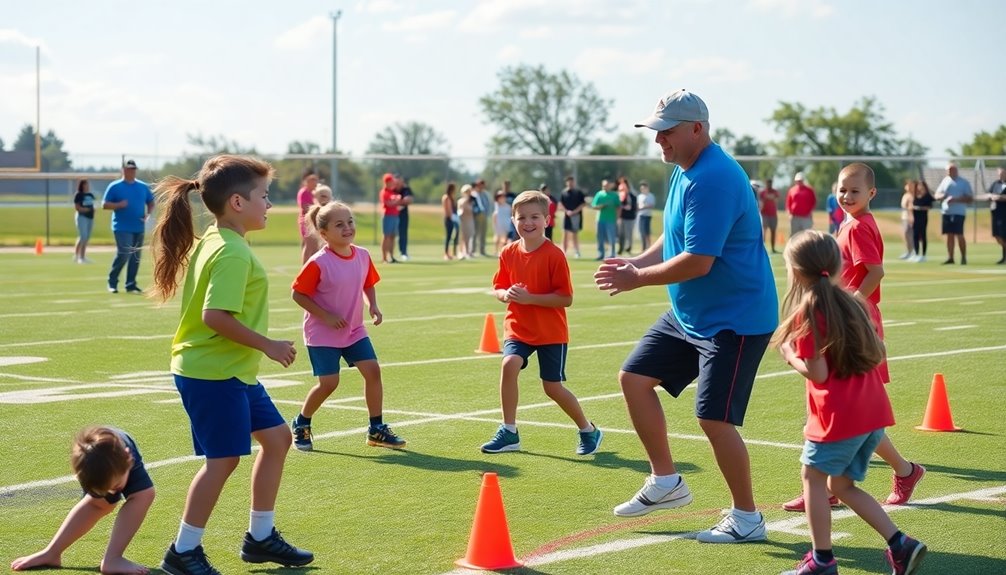
Creating a fun and engaging practice environment is key to keeping your players excited about flag football. Incorporate enjoyable drills like "Chase the Chicken," which not only makes practice fun but also helps players learn essential skills such as agility and flag pulling.
Utilizing music during warm-ups can notably boost team morale and create a lively atmosphere that energizes everyone.
Encourage creativity in your practice activities by varying drills and introducing new challenges. This keeps players engaged and enthusiastic to improve while ensuring that enjoyment remains a priority.
Remember, the more fun they have, the more likely they're to stay committed to the sport.
Actively involve your players in decision-making about practice activities. When they feel a sense of ownership, their enthusiasm for training increases, fostering a positive environment. Additionally, fan support can play a crucial role in boosting team morale and enhancing the overall experience for young athletes.
Emphasizing enjoyment in youth sports leads to better experiences and higher retention rates among your players.
Incorporating Team Building Activities
Incorporating team building activities at the start of practice is essential for fostering strong relationships among players. These activities not only enhance communication but also promote team cohesion, creating a positive practice environment. Additionally, engaging in quality training sessions contributes to maintaining motivation throughout the season. Sports serve as a platform for unity and understanding, transcending racial divides and enhancing teamwork.
By establishing familiarity among teammates, you set the stage for improved teamwork and enhanced performance during games. Additionally, engaging in team building activities nurtures mental toughness which is critical for high-pressure performance on the field.
Here are three engaging team building activities you can try:
- Introduction Circle: Have players sit in a circle and share their names and previous Flag Football experience. This simple activity lasts about 5 minutes and encourages engagement.
- Excitement Expressions: Invite players to express their excitement about the upcoming practice by jumping or making silly faces. This fun exercise helps break the ice and lightens the mood.
- Trust Falls: Pair players up and have one fall backward while their partner catches them. This builds trust and reinforces the importance of relying on one another during play.
Regularly incorporating these team building activities strengthens relationships and fosters trust, ultimately enhancing your team's overall performance.
Setting Clear Objectives
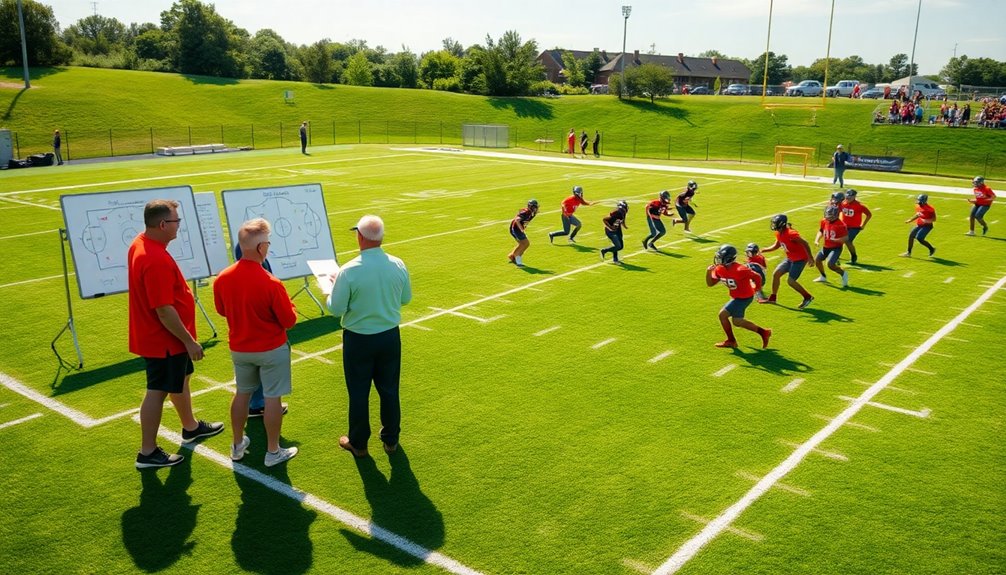
Setting clear objectives is essential for maximizing the effectiveness of your flag football practices. Start each practice session by establishing specific goals, like improving passing accuracy or enhancing flag-pulling techniques. This gives your players a clear focus and direction. Communicate these objectives at the beginning, so everyone understands the intended outcomes and can work together toward them.
Structure your drills to help achieve these defined objectives. For instance, if you're focusing on flag-pulling techniques, incorporate targeted drills that reinforce these skills. This targeted approach not only boosts skill development but also guarantees that practice time is used efficiently.
Regularly assess progress towards these goals during practices. This keeps players accountable and motivated. Use feedback from your team to adapt and refine your objectives throughout the season, guaranteeing they remain relevant to the team's evolving needs.
Conclusion
By crafting an effective flag football practice plan, you're not just sharpening skills; you're building a team that thrives together. Remember, each drill and scrimmage is a stepping stone toward success, so keep the energy high and the spirits higher. Hydration and fun are your secret weapons, ensuring everyone stays engaged and motivated. As you set clear objectives, watch your team transform from individual players into a cohesive unit, ready to conquer the field!

